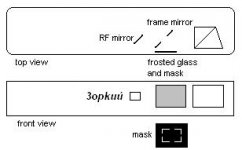rxmd said:
So basically I would have to find the focus point of the back lens and add a glass plate with some lines there (or just a crosshair) if it happens to be in free air, or hope that it falls on a lens surface and put some lines on this particular lens.
Yes, basically that would be the principle. You'd have to hope that the best focus point fell at some accessible location. With the top cover removed from the camera, I suppose it would be fairly easy to take a small object such as a wire, and move it around in the optical path to see if you could find a location where it was reasonably in focus when the eye was viewing through the eyepiece.
Etching framelines doesn't add significantly to the cost of making a camera, so I have to assume that if it were easy, the original designers would have done it. Still, might be worth investigating, if only to gain a greater appreciation of the problems of camera design.
I guess projected framelines would be easier to do as long as they don't have to be in focus, but then there's the problem of finding enough free space in the viewfinder.
Yes, space would definitely be a problem -- I think some of the shutter-timing mechanism winds up being in the space where the projection optics would need to be. You'd still need to plan things so the framelines wound up in fairly good focus -- that type of viewfinder isn't of much use if they're not -- but at least there'd be the possibility of incorporating an auxiliary lens to bring them into focus, if there was room. I've seen this in some viewfinders: a rectangular positive lens for focusing the framelines, with a hole in the middle of it so the rangefinder image can pass through.
Since we're at it anyway, another viewfinder marvel I've been wondering about is collimated rangefinders - I was wondering about why some rangefinder patches are sharply delimited while others aren't. Does this work similarly, i.e. the edge of the rangefinder patch simply being in focus?
Yup, that's the basic principle. The rangefinder incorporates extra optics to form its virtual image at the plane of a mask, and then there are more optics on the other side to bring the edges of the mask into focus at the eyepiece.
Getting the rangefinder image, the mask, the framelines, the viewfinder image, and often a meter readout ALL come into focus at roughly the same distance, so the eye can see them all sharply, requires a rather complex optical system of positive lenses, negative lenses, mirrors, beamsplitters and masks -- all precisely adjustable and all packed in to a tiny space. This is the main reason a modern rangefinder camera is more expensive than an SLR with otherwise similar specifications!


